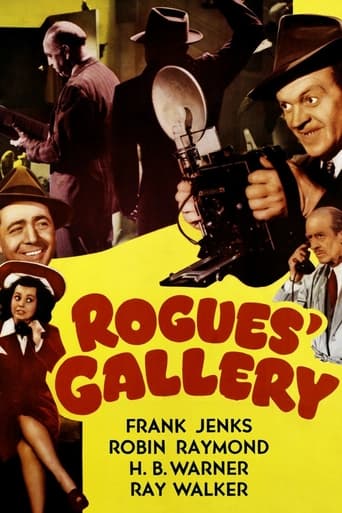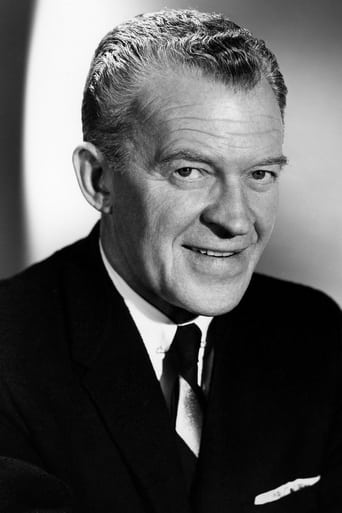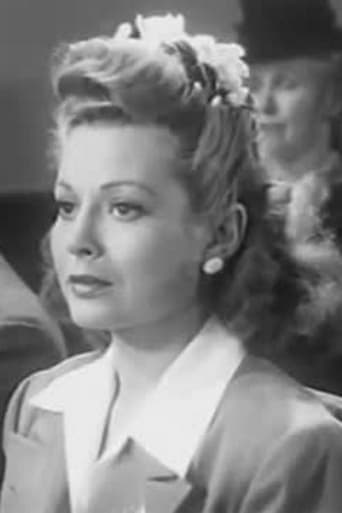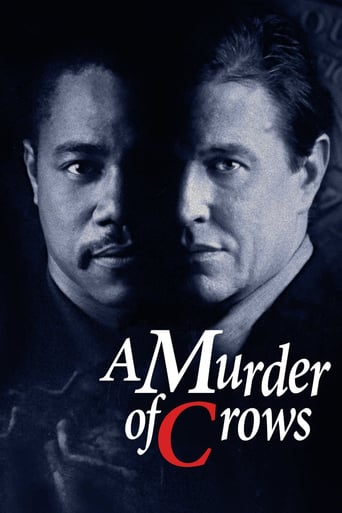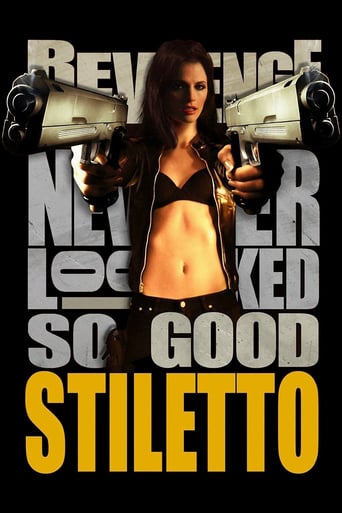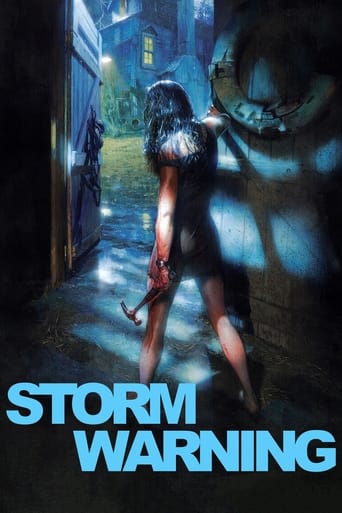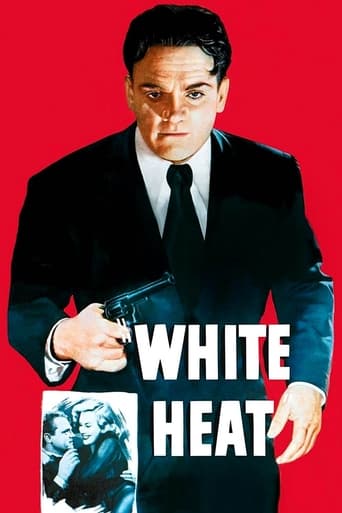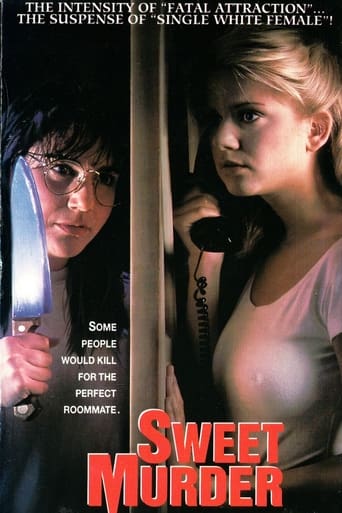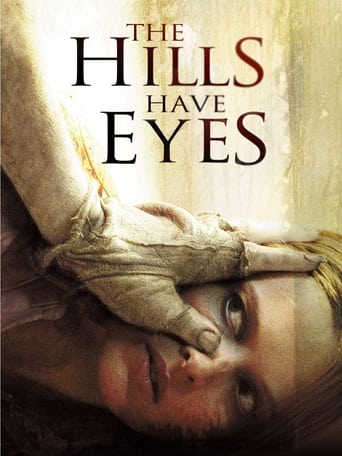Rogues' Gallery (1944)
Reporter Patsy Reynolds and photographer Eddie Porter are assigned to interview John Foster, head of the Emmerson Foundation regarding a listening device the organization is working on. Foster evades them and they to the lab to see Professor Reynolds, the real inventor. Soon, they are involved in several shootings, blueprints that change hands several times, a corpse in their car that appears and disappears a few times, the loss of their jobs and several people who either think they are killers or candidates for being killed.
Watch Trailer
Cast
Similar titles
Reviews
Best movie of this year hands down!
Best movie ever!
Good films always raise compelling questions, whether the format is fiction or documentary fact.
Through painfully honest and emotional moments, the movie becomes irresistibly relatable
Typical wacky 40s crime-mystery-comedy involving the attempted theft of an invention of a super eavesdropping device. There's a couple of murders along the way as the flick evolves into a whodunit. Robin Raymond stars as the wise-cracking newspaper reporter assigned to get the story on the invention. She's good if somewhat abrasive in the role with good delivery of some funny comebacks. Frank Jenks is her photographer in tow and is distractingly stupid. Ray Walker is the obligatory reporter from the competitive paper, providing an occasional sparring partner for Raymond, and happens to be the nephew of the head of the institution of where the invention occurred. The movie title is baffling because there is no Rogue's Gallery because there are no obvious suspects. Nevertheless, the movie is fun and fast paced. It's an okay time waster but don't make an effort to seek it out.
For the second day in a row I'm forced to use the word 'brainless' to describe a movie I've just watched. Yesterday it was the Bowery Boys in "Master Minds", but with them you expect a bit of nonsense to go with the story. "Rogues Gallery" is just a mess from the word go, as a couple of investigative reporters from the Daily Express attempt to get the scoop on a new invention and the murders that follow trying to steal those plans.What I wonder about when I watch a film like this is how any of the players could possibly make any sense out of the story. The drawings for this top secret listening device trade hands a number of times, while a couple of dead bodies wind up here and there in a dubious version of musical chairs. The invention at the center of the story was interesting though, a form of wireless communication that could pick up voices at a distance. Cell phone anyone? Now that I think about it, how secret would those plans be once they appeared in the newspaper? Those Emerson Foundation guys opened up the diagram of the device so Eddie Porter (Frank Jenks) could take a picture for the front page! The film could probably have been more tolerable if the chemistry between photographer Eddie and reporter Patsy Clark (Robin Raymond) worked a bit better. Most of the time their banter fell flat, while the whistling gag was annoying the first time around. They even used the old lights out trick, not once but twice to have the invention drawings disappear. You would think there'd be a safe in that big old lab where they could have kept them in one place for a while.Probably the thing that kept me going with this flick was the uncanny resemblance the two leads had to other actors of the era. Frank Jenks kept reminding me of Bob Hope, while Robin Raymond came across like a poor man's Martha Raye. Interesting because Hope and Raye teamed up in a dubious romantic comedy of their own five years earlier, in 1939's "Never Say Die".
The most distinguished member of the cast is H.B. Warner (and he was pretty distinguished). Robin Raymond (Patsy) seemed to appear in mostly uncredited bits until "Rogue's Gallery" - obviously, she didn't make people sit up and take notice so it was back to uncredited bits for her. Frank Jenks is the most recognized player, he seemed to pop up in just about every other film in the late 30s and all through the 40s.He is the star of this dubious crime drama and plays Eddie Porter, who along with a very irritating and aggressive reporter Patsy, are sent to interview Professor Reynolds (H. B. Warner). He is working on a machine that will pick up sound and voices from a distance, without the aid of a radio transmitter but before the intrepid two can get there, he is shot. As the villain makes his getaway, he drops a book of drawings that Patsy picks up. Before they can get back to the office they are held up but Eddie takes a picture and the villain is blinded by the flashlight. Eddie and Patsy then go to the group of scientists working on the plans and ask for an interview in exchange for the plans. They are just finishing the interview when the lights go out and another attempt is made to steal the drawings. Patsy feels she is the target as the villain thinks she may have seen him. By now the viewer is thinking - who cares???? It is obvious why Robin Raymond was not a successful actress. She seemed to have an abrasive personality, as one of the other reviewers says, and she didn't have the looks so that you could overlook her obnoxious personality. By now a body has been found on the porch, then when the police are called it mysteriously disappears. It then reappears not only in Patsy's car but in the police chief's car as well. Eddie and Patsy are convinced one of the scientists is behind it (even the most interesting character in the film, Duckworth, the butler (George Kirby) is acting suspicious, but that would be too easy, wouldn't it?????)
This is one of those silly 1940's mysteries with an aggressive female reporter and her half-wit cameraman, trying to get a really big "scoop." They go to the laboratory of a scientist who has invented a device for listening in on people, no matter where they are. There are a couple murders and bodies disappearing. The huffy police detective who is constantly being called to investigate things that change before he arrives. He grunts and snarls. He won't admit it, but he really likes Patsy, the reporter. There are many pratfalls, one, where the butler barely touches the cameraman and he goes flying through the living room, landing in an easy chair. It adds slapstick, which, in this case, is a distraction. The invention is taken for granted and used in the solution of the crime. It implies that there are such devices. To this day, we have nothing like this. The byplay between the two principles is pretty funny. There are some good character actors, doing slow burns, sneaking up on people, sounding very sombre. I'm a sucker for these old movies and did get a kick out of this one.
